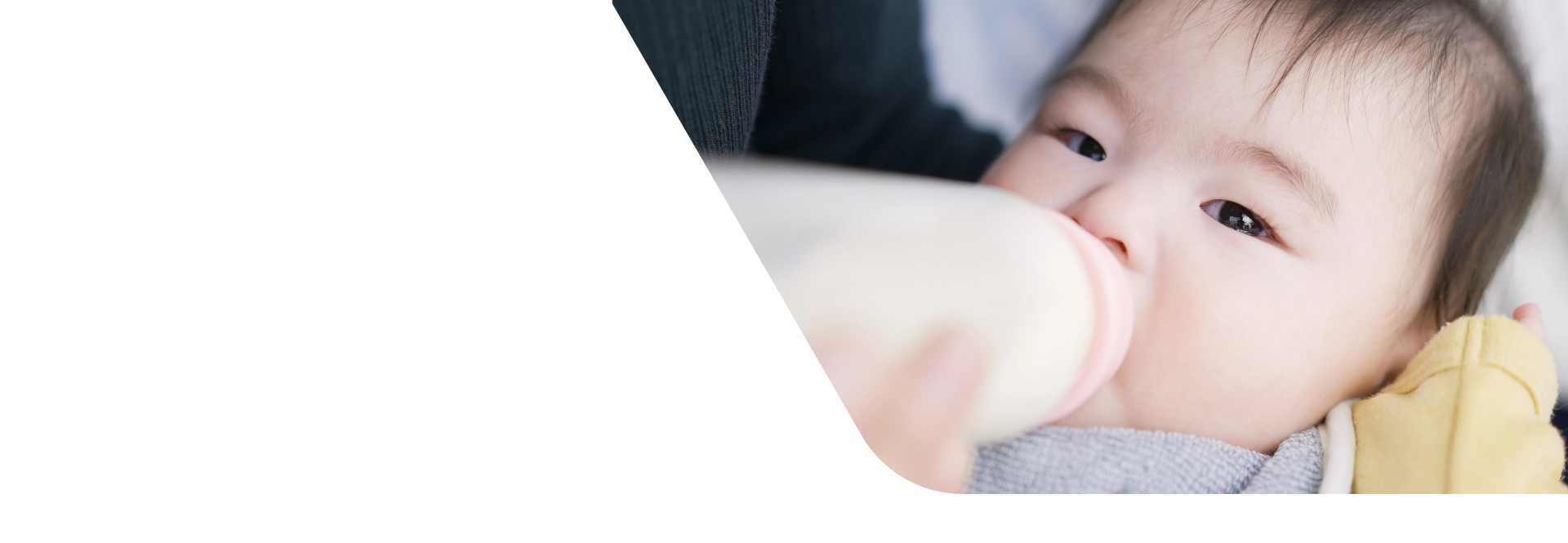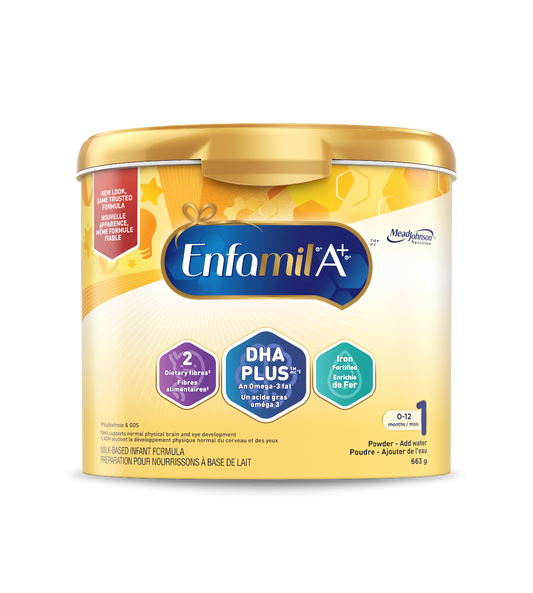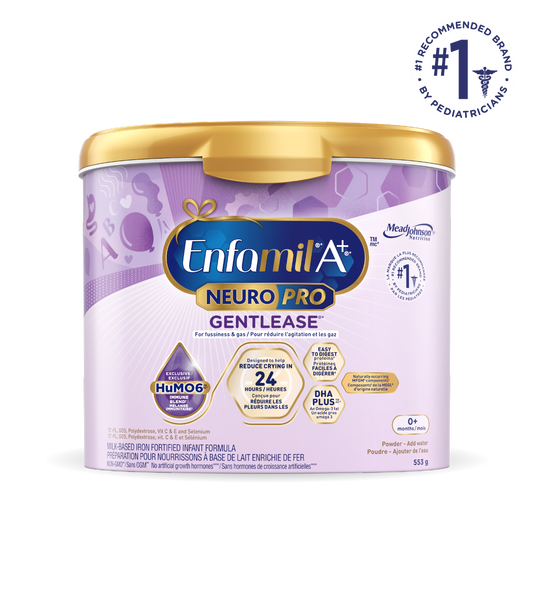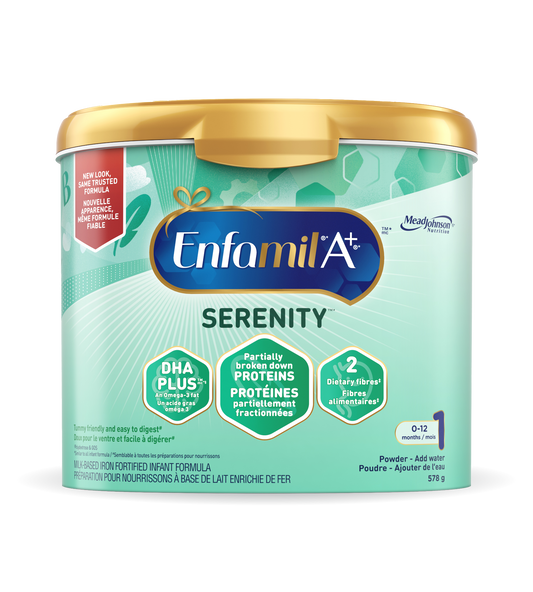If you plan to introduce formula, either as a supplement to breast milk or exclusively, you’re not alone. Recent consumer studies show that 9 out of 10 new mothers use formula at some point during their baby’s first year. They do it for many reasons, including to supplement breastfeeding, to share feeding duties and to make the transition back to work.
Planning on using formula?

You’re not alone
Breastfeeding is best for babies and is preferred whenever possible. However, if you choose formula, you’re not alone. In fact, recent consumer studies show that 9 out of every 10 new mothers use formula at some point during their baby's first year―including as a supplement to breast milk. The truth is, today's infant formulas are closer to breast milk than ever before and contain the nutrients your baby needs to grow and thrive.

Choose a formula with DHA
DHA is a brain-nourishing nutrient and an important nutrient in breast milk. A panel of experts recommend* that infant formula contains approximately 0.2%–0.5% (~7.2–18 mg) of docosahexaenoic acid (DHA) per 100 mL.
* Koletzko B et al. J Perinat. Med. 2008;36:5-14

Stock up on bottles and nipples
Babies can be picky, so buy a few different styles of bottles and nipples and see which ones your baby likes best.

Bond while formula feeding
Cuddle, snuggle, and sing to baby just as you would during nursing, and enjoy the love fest. Bonus: bottle feeding gives Dad, Grandma and even siblings a chance to bond as well.

Ensure that grandparents and babysitters know how to prepare a bottle
Preparing formula isn’t hard, but you will want to stress the importance of following label instructions. With everyone on the same page, you can rest assured that your baby will get the nutrition they needs.
Formula feeding
Concerned about nutrition?
Thanks to decades of research and scientific advancements, today’s infant formulas are closer to breast milk than ever before and contain the nutrients your baby needs to grow and thrive.

I used Enfamil A+ for my first child when my breast milk stopped producing. It was a saving grace. I now have a second child who just turned a month old and is on the same formula. I absolutely love the formula.

Formula feeding guidelines
How to introduce a bottle
Most Moms find formula feeding easy—but introducing a bottle may take some trial and error. Here are 5 ways to make it easier:
Make it gradual
Start by giving one bottle a day and gradually build up. Another way to supplement is to let your baby nurse first and then finish off with formula.
Time it right
Try offering a bottle when your baby is hungry but not famished, so they're less likely to fuss. In most cases, the optimal time to start supplementing is after the first month so your milk supply is well-established.
Let Dad or Grandma offer the first bottle
This can work better because your baby may associate you with strictly breast milk at first.
Start out with breast milk in the bottle
This cuts down on the number of new experiences baby has all at once. Plus, the familiar taste may help them to accept the bottle faster—and once they befriend it, adding formula won’t seem like a big deal.
Use a bottle nipple that resembles your baby’s pacifier
Putting some breast milk on the nipple is another way to encourage them to accept the bottle. Once your baby tastes the breast milk, they may start sucking to get more.
How to prepare baby formula
Become a mix master
Making formula isn’t hard. Just follow the directions on the label, consider these important tips, and in no time you’ll be an expert. But remember—accuracy matters. Too much or too little water and your baby won’t get the right mix of nutrients.
Bottle basics every Mom needs:
- Follow label directions carefully
- Always use formula before the expiry date
- Wash your hands and your work area
- Boil clean bottles, nipples, caps and utensils in water for 2 minutes
- For healthy term babies less than 4 months old, boil the water you use to make formula for 2 minutes. Let the water cool down before use.
- Run warm tap water over the bottle or place the bottle in a pan of hot (not boiling) water. Shake bottle occasionally while warming. The warming time should be less than 15 minutes. Test the formula temperature before feeding; it should not feel warm or cold when dropped on your wrist.
- NEVER microwave a bottle—you could seriously burn your baby
- If there’s any formula left in a bottle, throw it out within 1 hour of starting the feeding
How much formula to feed your baby?
Formula feeding. How much? How often? Is your baby getting enough to eat?
Generally, formula fed babies eat every 3-4 hours during their first weeks, while breastfed babies eat every 2-3 hours.
Proper weight gain is the truest test of whether or not your baby is eating enough. Here’s another test—count their wet diapers. If you get six or more per day, and your baby is happy between feedings, they're likely getting plenty to eat. Don’t try to force your baby to continue feeding when they're not hungry.
If you are exclusively formula feeding, here’s a guide to how much and how often you should feed formula to your baby. But remember, these are just averages—your baby’s appetite is always the best guide.
Formula feeding chart
| AGE |
BOTTLES per day |
APPROXIMATE AMOUNT OF FORMULA per bottle per day |
|
|---|---|---|---|
|
Birth–1month
|
5-10 | 59 mL (2 fl oz) - 89 mL (3 fl oz) | |
| 1 month | 5-10 | 59 mL (2 fl oz) - 89 mL (3 fl oz) | |
| 2 month | 5-10 | 59 mL (2 fl oz) - 89 mL (3 fl oz) | |
| 3 month | 4-7 | 89 mL (3fl oz) - 150 mL (5 fl oz) | |
| 4 month | 4-7 | 89 mL (3fl oz) - 150 mL (5 fl oz) | |
| 5 month | 4-7 | 89 mL (3fl oz) - 150 mL (5 fl oz) | |
The amount of formula your baby needs, and how often he/she needs to eat it, depends on his/her stage of development. These are some general guidelines. Please contact your doctor to discuss any questions, as they know your baby best and are in the best position to guide you.
How to store baby formula
Prepared bottles of formula (from liquid, concentrate or powder) should be refrigerated and used according to the table.
-
Refrigerated bottles (2-4°C, 35-40°F):
- Formula made from powder: good for 24 hours
- Ready to feed liquid formula or formula made from concentrate: good for 48 hours.
- Bottles at room temperature
- All forms of formula: good for 2 hours. If bottle is warmed, good for 1 hour
- Bottles after feeding begins
- All forms of formula: use within 1 hour or discard. Do not refrigerate leftover formula for later use.
Please note: Proper hygiene, preparation, dilution, use and storage are important when preparing infant formula. Powdered infant formula is not sterile and should not be fed to premature infants or infants who might have immune problems unless directed and supervised by your baby’s doctor. Failure to follow these instructions could result in severe harm to your baby.








